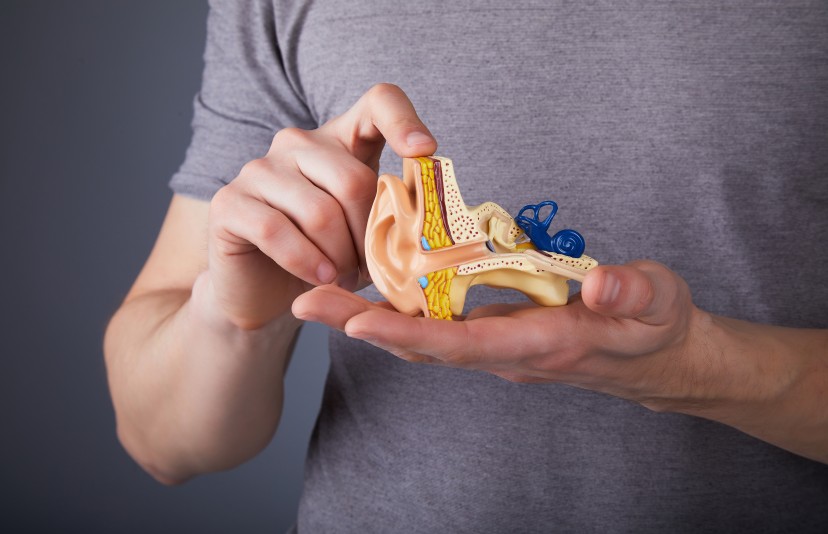
An operation performed to repair a hole in the eardrum is called Myringoplasty. In this process, the hole is fixed by placing a graft to patch up the eardrum. Usually, the graft is taken from tissue that is found behind the ear.
ABOUT THE PROCEDURE
Myringoplasty is a surgical process to repair a hole in the eardrum. Perforation in the ear of any kind can be usually caused by an infection in the middle ear that bursts through the eardrum. It can also result from trauma (for example, being hit across your ear or by putting any foreign object inside the ear). Often a perforated eardrum does not cause any problems, but it can lead to repeated infections inside the ear and poorer hearing. Myringoplasty is usually performed by an otolaryngologist. The procedure involves repairing of the hole by placing a graft made of either a gel-like material or a small piece of tissue from elsewhere on the body.
WHY IS THE PROCEDURE PERFORMED?
This surgery is conducted to repair a hole in the eardrum.. Constant pain in the eardrum requires surgery, and if the existing damage is significant, it will create further damage to other parts of the ear. The surgery results are usually positive with a high success rate. Many patients confirm that after surgery, their hearing capability has increased.
DIFFERENT TYPES OF PROCEDURE
There are three types of middle ear surgeries that are performed on patients.
1.Tympanoplasty: If there is a massive infection or a significant tear inside the ear and the patient does not respond to antibiotics, an operation is required. Firstly, the surgeon uses a laser to carefully remove any scar tissue or excess tissue built up in the middle ear. And then, a small piece of your own tissue will be taken from the muscle sheath or a vein and grafted onto the eardrum to close the hole. Your surgeon will now either go through your ear canal for repairing the eardrum, or make a small cut behind your ear and access the eardrum that way.
2.Myringoplasty: This surgery is performed for minor tears. This procedure patches the hole with a piece of tissue or gel, and the whole process takes around 30 minutes but may extend up to 3 hours depending on the complexity of the case.
3.Ossiculoplasty: This kind of surgery is required when three tiny bones and ossicles present inside the middle ear are damaged by a trauma or an infection. During operation, the damaged parts are replaced with the help of the donor's bones or with the use of prosthetics.
PREPARING FOR THE PROCEDURE
Before the Surgery
Before surgery, if the patient has an infection, it is advisable to use antibiotic drops to clear the infection. With infected ears, the chances of success are reduced.
During the Surgery
To prepare a graft, a small piece of fascia is taken from behind the ears. Sometimes a part of the ear cartilage is also used as a graft . Afterwards, the ear canal skin and eardrum are carefully approached and then the graft is placed inside the eardrum. A special dissolvable sponge is placed deep into the graft to hold it at the requisite place while healing. The cut behind the ear is closed with dissolvable stitches. In the first week, the soft sponge is put inside the ear which protects the eardrum that can be later removed.
After the Surgery
The patient often gets discharged on the same day or is kept under observation for one day at the hospital. A crepe bandage is placed to hold the ear dressing. There may be some blood coming out from the ear but this will happen only for a few days. It can be prevented easily by placing a cotton ball inside the ear, which needs to be changed often. Most importantly, you need to avoid getting the ear wet. Later, the doctor will carefully remove the bandage from the ear canal and check the stitches. Healing usually takes one to three months of time and in between, hearing tests are conducted to check the hearing capability. It is also recomended not to travel by plane for two to three months after the surgery.
BENEFITS OF THE PROCEDURE
· Restores hearing loss and in certain cases cures tinnitus
· Prevents re-infection from the external auditory canal and eustachian tube
· Prevents aeroallergens reaching the exposed middle ear mucosa, leading to persistent ear discharge
· Fewer chances of other types of ear infections
· Hearing power is enhanced
RISKS OF THE PROCEDURE
All surgical procedures carry some risks. Some of these general complications include:
a. Blood clots
b. Bleeding
c. Scarring
d. Pain
f. Allergy due to the equipment used, materials, or medicines
g. Dizziness
Possible complications specific to this procedure are:
a. Taste changes
b. Loss of hearing
c. Numbness of ear
e. Tinnitus
f. Failure of the graft

Why Choose Apollo Healthcare?
Established By Dr Prathap C Reddy In 1983, Apollo Healthcare Has A Robust Presence Across The Healthcare Ecosystem. From Routine Wellness & Preventive Health Care To Innovative Life-Saving Treatments And Diagnostic Services, Apollo Hospitals Has Touched More Than 120 Million Lives From Over 120 Countries, Offering The Best Clinical Outcomes.
7,000+Healing Hands
4,000+Pharmacies
170+primary care & diagnostic clinics
70+Hospitals
Frequently Asked Questions
1.Does this procedure improve hearing?
It helps to prevent middle ear infections that can occur repeatedly and improve hearing capabilities.
2.How does a person feel after surgery?
The person has a bandage for up to 24 hours and dressing is required in the ear canal for a few weeks. It feels like the ear is blocked during this time period.
3.How to speed up recovery after the surgery?
Nutritious food along with a good amount of rest helps to heal faster. Try eating healthy food and drink lots of water regularly.






